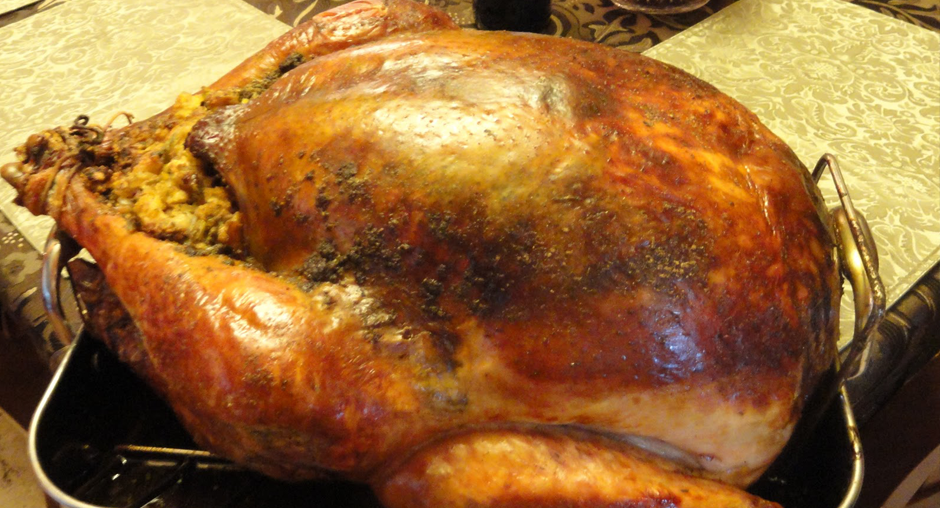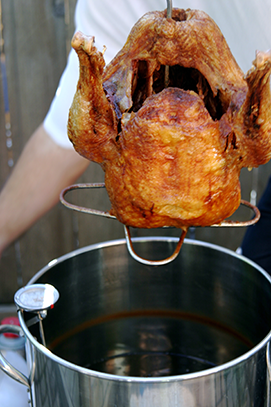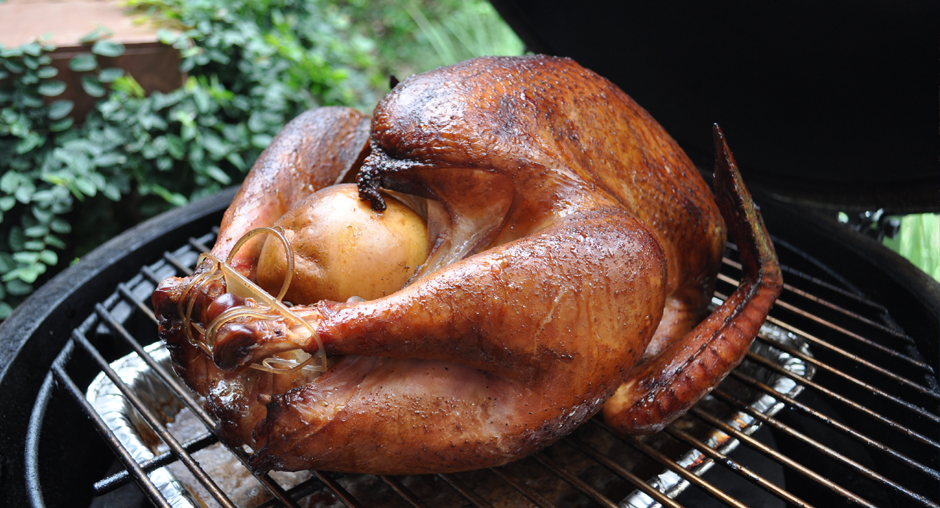Three Ways to Cook Turkey

Throwing a Twist on Tradition
STORY BY: KRIS BEASLEY
If I close my eyes, I can smell the mouth-watering aroma of the Thanksgiving turkey roasting in the oven at my folks’ house. I am not sure if there is a better smell on earth! In fact, I think they should come out with a seasonal candle that smells like turkey and dressing!
While nothing can replace my mother’s roasted bird, I thought it would be interesting to research some other ways to cook a turkey and perhaps discover a new method and tradition.
1. SIMPLE ROASTED TURKEY
• 9-pound turkey, raw
• 10 quarts brine (recipe below)
Place the turkey in 20-quart container.Pour the cold brining liquid over the turkey and let turkey brine for 10 hours. When it has brined 10 hours, remove from the liquid and place on a tray to dry out. Place the turkey on a roasting rack on a tray and cover with lid or tin foil. Place in oven. Roast at 350°F until an internal temperature of 165°F is achieved. Roughly 15 minutes per pound.
*Baste with butter every 30 minutes. Uncover to brown the turkey the last 30 minutes or so.
TURKEY BRINE (YIELDS: 6 PORTIONS)
• 4 quarts water
• 6 quarts ice water
• 1 bunch thyme
• 1 bunch parsley
• 1 1⁄2 cups kosher salt
• 5 lemons cut in half
• 2 bay leaves
• 1⁄2 cup honey
• 2 garlic heads, cut in half crosswise
• 3 tablespoons whole black peppercorns
EQUIPMENT FOR BRINING
• 12-quart pot
• 20-quart container
In the 12-quart pot, combine 4 quarts of water with the remaining ingredients in a large pot. Cover and bring to a boil. Stir until salt is dissolved, then remove from the heat.Transfer to 20-quart container and add the 6 quarts of ice water. Let cool completely.Lower the turkey into the brine and refrigerate for 24 hours.
2. DEEP FRIED TURKEY WITH CAJUN RUB 
Safety First: I cannot stress enough here about the safety factors involved in this dish, so please follow the safety tips carefully, stay safe and enjoy this dish with a difference.
I have included a list of all the required equipment, notes about the oil required along with the cooking method and the recipes for various dry rubs for you to add an extra twist each time you cook your bird.
Location and Safety: Place the gas burner on level dirt or grassy area, ensuring that it is stable. Never fry a turkey indoors, in a garage or in any other structure attached to a building. Avoid frying on wood decks, which could catch fire, and concrete, which can be stained by the oil.
EQUIPMENT REQUIRED
• Extra large saucepan / stockpot / pasta pot
• Portable gas burner
• Large food basket
• Food thermometer for the oil temperature
• Oven cloths / mitts
• Fire extinguisher
• 2 – 4 house bricks or similar
• Large tray with sand
• Oil – Choose an oil/fat that has a high smoking point. It will need to be stable at 350 degrees – peanut, canola, safflower will work.
To exactly measure the amount of oil required:
1. Place the turkey into the pot
2. Add water until it covers the turkey by approx. 2 inches. The level of the water should be at least 6 inches from the top
3. Measure the amount of water used, and use that amount of oil
Safety note: Be sure to thoroughly drain and dry off the turkey, inside and out. Any water remaining will cause a safety hazard later when immersing it into the hot oil.
CHOOSING A TURKEY
Choose a small bird approximately 6-8 pounds. Anything larger will not fully cook and may also cause safety issues such as lowering and lifting from the hot oil.
TURKEY PREPARATION
The turkey may be left un-seasoned or a dry rub used for extra flavor. These are best rubbed into the bird a day or two ahead to allow the flavors to penetrate and develop. Rub the seasoning into the cavity and under the skin for maximum effect and to minimize the contamination of the oil.
Do not inject the turkey with liquid marinades, as this only adds moisture content and can cause excess bubbling of the oil as it cooks and can be a major fire hazard if not completed properly.
Do not stuff the turkey.
Cooking: It cannot be stressed enough that the turkey must be thoroughly dry before commencing any further. Even if you dried it before, check and pat dry inside and out once again.
Place the oil into the pot and place over a medium heat – depending on the amount of oil used, this will take up to 1 hour. Once the oil has come to temperature, place the turkey in the basket and slowly lower into the fat.
Cook for approximately 5-10 minutes per pound
After two-thirds of the estimated cooking time, carefully remove the turkey and check it, this can be done by the use of a meat thermometer (the temperature at the core of the thickest part of the breast must reach 160 degrees).
Alternatively cut the skin between the leg and the breast and carefully pull apart slightly, look for any signs of pinkness or rawness at the thigh joint. If present repeat with the other leg and slowly place back into the oil to complete the cooking by separating the skin in this way the heat now penetrate to the thigh joint and cook it without over cooking the breast.
When cooked, turn off the heat source.
Carefully remove the basket and allow the excess fat to drain away. A couple of bricks placed on the ground are ideal for resting the basket on, to allow it to drain. A shallow tray of sand is ideal for catching the dripping oil; it makes for easy removal and keeps your area clean.
Additional Safety Tips: Never leave the oil heating when unattended.
Never leave the turkey cooking when unattended.
Don’t allow children or pets anywhere near the cooking area.
When cooked, turn off the heat source before removing the basket – this ensures any dripping oil will not catch fire and set alight the whole pot of oil.
Allow the oil to cool completely before moving the pot, disposing, straining or storing of the oil.
Immediately wash hands, utensils, equipment and surfaces that have come in contact with raw turkey.
Turkey should be consumed immediately and leftovers stored in the refrigerator within two hours of cooking and used within two days.
SMOKED TURKEY ON THE GRILL
CAJUN SPICE RUB
• Sea Salt Flakes 1/2 cup • Onion Powder 3 TB
• Garlic Powder 3 TB
• Black Pepper 2 TB
• White Pepper 2 TB
• Sweet Basil 2 TB
• Smoked Paprika 1 1/2 TB
• Cayenne Pepper 1 TB
• Bay Leaves-ground 2 tsp
• File Powder 2 tsp
Combine all ingredients thoroughly
COOKING TIPS
Adjust the cayenne to suit your own taste.
File powder is dried, ground sassafras leaves, also known as filé or gumbo filé, (pronounced fee-lay). It is used frequently in Creole and Cajun cooking. First known use was by the Choctaw Indians of Louisiana. It is used as a seasoning and primarily thickening agent in gumbo and has a wonderfully pungent and aromatic flavor.
*When added to gumbo never add it while it is cooking, add at the end when the gumbo is off the fire (it is best when you sprinkle it on, cover the pot and let it sit for 15 minutes). If brought back to a boil it will turn stringy.

3. SMOKED TURKEY ON THE GRILL
• 1 Turkey (14 lb or smaller)
• 3/4 tsp Salt and Pepper- each
• 6 sprigs Fresh Sage
• 1/3 cup White Wine Vinegar
• 1/3 cup Vegetable oil
• 2 tbsp Chopped fresh Sage, Rosemary, Thyme and Parsley – each • 1 tbsp Dijon mustard
FEELING INSPIRED? THEN TRY THESE EXTRAS
Apple Wood or other wood chips (fruit woods tend to work well with turkey) to add flavor – soak for 30 minutes, drain well, place in smoker box under grills for tremendous smoke flavor.
Stuff the body cavity as you would for roasting in the oven (adds time, adds flavor too). Anything will do, but here’s a good recipe: Combine 2 cups chopped onion, 1 chopped granny smith apple, 1 tablespoon chopped sage, 1⁄2 tsp salt and 1⁄2 tsp pepper. Stuff bird.
INSTRUCTIONS
1. Remove neck and giblets from turkey. Rinse inside and out and then pat dry. Place sage sprigs in cavity. Skewer neck skin to back. Using kitchen string, tie legs together and wings to body.
2. In bowl, whisk together vinegar, oil, chopped sage and mustard; set aside. 3. Heat 1 burner of a 2-burner barbecue grill or the 2 outside burners of a 3-burner barbecue grill to medium (if you have more than three burners – just make sure you’re keeping the outside of the barbecue warm and the middle of the barbecue cool).
4. Place foil drip pan under unlit burner(s). This foil pan will fill with the drippings, which make delicious, smoky gravy. Ensure that the heat from the rest of the barbecue is not too close to the drip pan otherwise your drippings will bubble, evaporate and possibly burn.
5. Place turkey – breast side down – on greased grill over unlit burner(s), cover breasts with foil (very important – it keeps the breast meat from drying – white meat cooks faster than dark, so the foil slows the cooking).
6. Close lid and cook, brushing every 45 minutes with vinegar mixture and adjusting heat to keep temperature between 250 and 300 degrees for 3 1⁄2 to 4 hours or until meat thermometer (remote or otherwise) inserted in thigh registers 180 degrees.
7. Remove the foil from the turkey breast after 2 1/2 hours of roasting.
8. Transfer to cutting board. Tent with foil (the whole bird this time) and let stand for at least 20 minutes before carving.











Leave a Reply